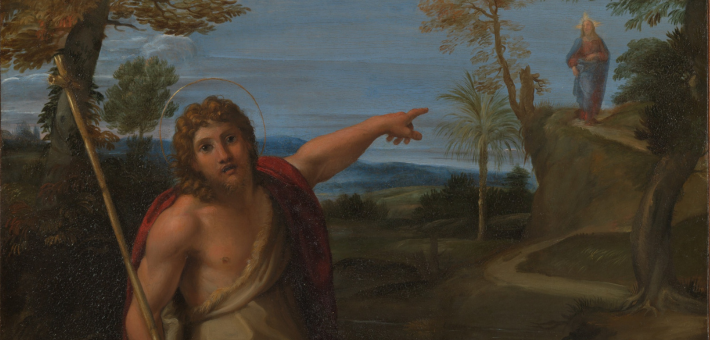Commentary on Luke 3:7-18
Good news can take different forms.
John the Baptizer’s message is an example. More than any other Gospel, Luke reports the content of John’s message. He addresses hearers as a “brood of vipers,” calls for “fruits worthy of repentance,” and issues a barrage of metaphors that convey urgency: wrath to come, an ax lying at the tree root, a winnowing fork, and chaff burning in an unquenchable fire. The text concludes: “With many other exhortations, [John] proclaimed the good news to the people” (verse 18). Some good news, huh?
But John’s message is more constructive than condemning—and more expansive than excluding. Repentance in Luke, after all, leads to joy and a life better aligned with God’s purpose. And that is good news.
Lukan distinctives
While all Gospel accounts say something about John’s message, several distinctives to Luke’s version make it longer, more universal in scope, and rounded out by tangible examples.
First, John’s preaching addresses not just religious leaders (as in Matthew 3:7–10), but crowds coming out to be baptized (Luke 3:7). This makes his audience more expansive. It opens the door more readily for hearers and readers of Luke’s Gospel—in Luke’s day and ours—to see themselves as somehow part of John’s audience.
Second, the passage spotlights a question that becomes a leitmotif in Luke-Acts: “What should we do?” Here the question appears three times, giving it emphasis. It also appears near the start of both Luke and Acts, reflecting a response of repentance associated with a divine arrival (Luke 3:10, 12, 14; Acts 2:37).
Third, Luke offers tangible examples of what repentance looks like. In response to John’s message, three different groups ask for guidance: the crowds, tax collectors, and soldiers. To each, John gives distinctive instructions: share clothing and food (crowds), collect justly (tax collectors), and be content without extortion (soldiers). All three examples depict acts of generosity, justice, and contentment.
Unlikely responders: Tax collectors and soldiers
While Luke’s Gospel is known for “good news to the poor” (4:18), it is not just the poor who are addressed and included. John, for example, does not condemn tax collectors and soldiers.
Different than other Gospels, Luke portrays tax collectors favorably as people who respond to John’s and Jesus’ message (5:27–31; 7:29, 34), draw near to Jesus (15:1; 19:1–4), are capable of genuine piety (3:12–13; 18:9–14; 19:5–10), and are among the saved and true children of Abraham (19:9–10). Whether historically accurate or caricature, people widely associated tax collectors with bribery, great wealth, extortion of the poor, and betrayal of Jewish ethical mores. And yet, the good news is also for them.
The soldiers are also unlikely responders to John’s message. In the eyes of a people under an empire’s thumb, soldiers were its servants. Even though these soldiers likely were neither Roman nor Gentile, but Jewish locals employed by Herod, their paychecks still came from imperial systems—and everyone knew it. As John’s words confirm, their positions gave them regular opportunities for power abuse. And yet, the good news is also for them.
In today’s world, where polarizing caricatures of others are easier and more self-assuring than nuanced appreciations of their humanity and experience, the audiences who respond to John—and the way he takes them seriously—invite us to lay our stones down. The good news in Luke’s Gospel is for all—even those we deem threatening.
“What should we do?”: Repentance as good news
The question “What should we do?” appears not only here, but throughout Luke and Acts. It reflects not only the response of repentance, but also a concern for faithful action that marks a life realigned with God’s purpose (Luke 10:25; 12:17; 16:3; 18:18; 20:13; Acts 2:37; 16:30; 22:10). In Luke and Acts, repentance is not just a feeling—it means concrete acts of change. It amounts to recalculating the course of one’s life.
Our text offers tangible examples of what repentance looks like. In response to their questions, John describes to three groups of people what form generosity, justice, and contentment may take for them. His words offer practical steps to justice and generosity. In Acts, the early church will engage in similar practices in communal ways (2:41–47; 4:32–37).
While a call to repent may not seem like “good news,” it marks an invitation to a life better aligned with God’s purpose—and on that path, there is joy.
Elsewhere in Luke and Acts, repentance and conversion are associated with joy. In Luke’s parables, finding “the lost” yields rejoicing over “one sinner who repents” (Luke 15:6–7, 9–10, 32). In Acts, rejoicing becomes a characteristic response of Gentiles who join the Way (Acts 8:8, 39; 13:48, 52; 16:34; see also 15:31). Throughout Luke and Acts, joy is often associated with a faithful response to the presence and message of Jesus (Luke 8:13; 19:6).
The call to repentance may truly be good news. It invites us to take practical steps toward aligning our lives more squarely with God’s purposes—not just in theory, but in practice. It takes the internal and abstract aspects of faith and makes them external and concrete. It gives opportunity for faith to have full expression.
The call to prepare: The arrival of Jesus
John’s message derives its urgency from something very significant: the arrival of Jesus. In John’s day, Jesus’ arrival was imminently expected. In our day, his arrival is no less expected, but in different ways: at Christmastime, at his return, and in our lives here and now. In Advent, we consider how Jesus comes to us in all these ways.
John’s urgency may seem foreign to us. But John’s message calls us still to step away from our conventional patterns to let our sights be recalibrated on the One who draws near to us here and now, not just at Christmastime, but each and every day.


December 15, 2024